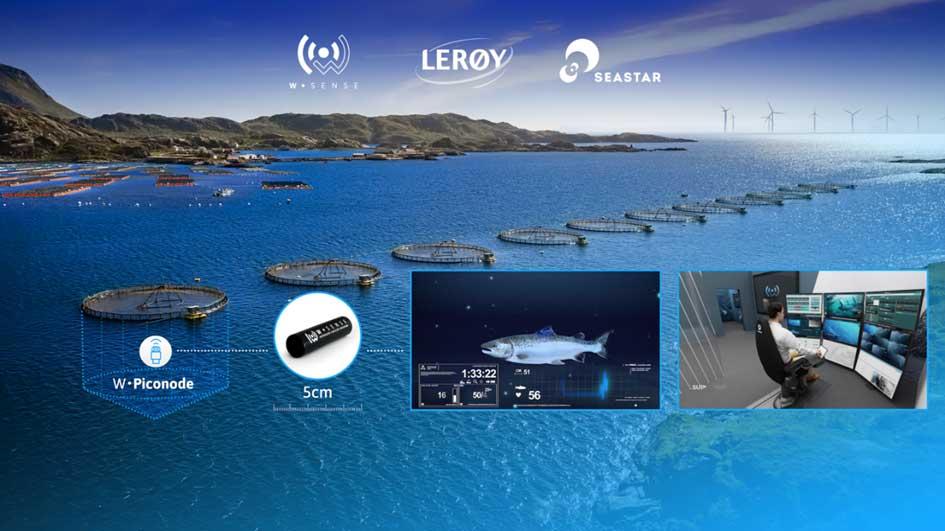
The recently published communication on international ocean governance sets the path of EU ocean policies for years to come. Among the key policies, there’s a set of EU commitments to support the innovation, sustainability and competitiveness of the aquaculture sector.
Those commitments are there for good reason: aquaculture is one of the most prominent food industry sectors in Europe and contributes vitally to food security.
Yet there are still many obstacles to the expansion of the aquaculture sector, which the EU is striving to overcome, both at policy and technological level, by supporting innovative ideas and digitisation.
The EU-financed SEASTAR (SurvEillance of Aquaculture farmS with neTworks of underwAter sensoRs) project is precisely one of those innovative ideas with the potential to change the way that the aquaculture sector works.
SEASTAR (set up by WSense srl, WSense AS, Leroy Seafood Group and the University of Bergen) addresses the lack of full digitalisation in the sector, which forces the aquaculture operators to perform daily tasks and monitoring activities manually or with costly in-situ interventions. SEASTAR performs the same tasks by exploiting innovative Internet of Underwater Things Technologies and integrating them with miniaturised wearable sensors to be placed on fish. The resulting system provides an innovative underwater wireless monitoring infrastructure that, for the first time, will allow fish farmers to monitor the health of fish remotely, in real time, and to gather relevant (water quality and cage structural integrity) data for accurate risk assessment, forecasting and management.
The architecture of the system built by SEASTAR is based on 4 pillars: W-Node, W-Gateway, W-Cloud and W-Pico.
W-Node is the underwater sensor node, connected to sensors and actuators: it receives the data, compresses it and transmits it through our underwater wireless mesh networks to a gateway. The W-Node is designed to easily integrate a wide array of sensors measuring, for instance, water quality, noise, and structural integrity.
The W-Gateway is the device which translates the underwater signals into information and sends them to a remote control center or the W-Cloud software platform. The W-Gateway is also an edge computer, supports signal processing and machine learning algorithms and is a component which can implement the aquaculture digital twin.
The W-Cloud software platform allows to store, analyse and visualise in real time data. The platform also allows sending commands through the W-Gateway to a node or set of nodes.
W-Pico, whose market ready. fully industrialised version is scheduled for Q3 2023 is the smallest existing modem (1cm by 5cm), with an integrated sensing board for real-time fish welfare and fish activity monitoring (fish position and depth, fish activity).
Control over large areas is ensured by the wireless mesh communication that ensures exchange of information at great distances, while precision control of assets takes place through an underwater GPS solution. All the components have been designed to be super low power and to last for years.
Project leader Claudia Petrioli [see her interview at EMD2022 in Ravenna] remarks:
In SEASTAR we have developed an innovative underwater wireless monitoring infrastructure that, for the first time, allows fish farmers to monitor the health of fish remotely, in real time, and to gather relevant (water quality and cage structural integrity) data for accurate risk assessment, forecasting and management. Our objective has been that of making aquaculture more competitive, as a key sector to provide food to a growing human kind, and at the same time sustainable.
The SEASTAR system is now mature, having been piloted for over six months in Italy and Norway, including the assessment by third party scientists. In addition the project has contributed to the definition of the AquaCloud 2.0 standard and to its full implementation, enabling integration of sensor data from different farms and sensors manufacturers into the monitoring system.
The leading technology developer, WSense group, has been able to develop a business plan for exploiting the results of the project which has attracted €2,5 million of private investments in a round closed just at the end of the project. Wsense has also developed an exploitation plan to bring the technologies to the global scale, opening a new round for bringing the company to the next level. The round has been launched at the Blue Invest day where WSense obtained the Blue Invest Award 2022, category Ocean Observation.
This potentially game-changing project not only brings obvious benefits to the industry sector, but dovetails many of the political priorities reaffirmed in the international ocean governance communication, beyond those specific to aquaculture, the European Green Deal and the Farm to Fork Strategy. The Internet of Underwater Things technologies provide monitoring systems supporting European regions in defining the best areas for aquaculture and offshore renewables, in line with the maritime spatial planning directive. Eventually, they also provide ocean knowledge, which is an enabler for the Digital Twin of the Oceans.
Did you like this story?
Then check out the June episode of Euronews OCEAN on international ocean governance
Keep informed about the project
Website
Details
- Publication date
- 4 July 2022
- Author
- Directorate-General for Maritime Affairs and Fisheries




